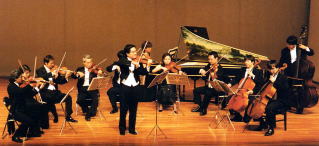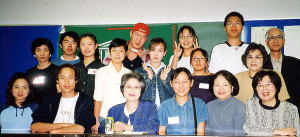Meguro UNESCO Short News
“Concert for Peace” Touched Hearts of Audience
|
On the fine Saturday afternoon of September 29, the “UNESCO Peace Concert-2001
in Tokyo” was held to commemorate the 50th anniversary of Japan's entry
into UNESCO at the Meguro City Hall. The concert was:
Sponsored by: Tokyo Metropolitan Board of Education, Tokyo Liaison Council
of UNESCO Associations, Meguro UNESCO Association,
Co-sponsored by: the Meguro Board of Education, the National Federation
of UNESCO Associations in Japan
Supported by: Meguro City, Meguro International Friendship Association,
Federation of Parents-Teachers-Association (PTA) of Meguro City Public
Primary Schools, Federation of PTA's of Meguro City Public Middle Schools,
Meguro City Federation of Children's Associations, and with Cooperation
of: Central Art School.
 During our President Kato's opening speech, everyone stood up to pray
for the repose of souls of the victims of the September 11 terrorism as
well as for world peace.
During our President Kato's opening speech, everyone stood up to pray
for the repose of souls of the victims of the September 11 terrorism as
well as for world peace.
The “Peace Concert” this year was made possible, as last year, out of
goodwill of Mr. Nobuhiko Asaeda, violinist. Last year he played together
with the ad hoc club for orchestra of Higashiyama Primary School, Meguro.
This year he played with the Amadeus Ensemble Tokyo as its concertmaster. The
concert was unique in the sense that the pupils of primary and middle schools
in Tokyo were invited to the concert free of charge. It was Mr. Asaeda's
idea that we should enjoy good classical music together with schoolchildren. The
popular music of Vivaldi, Bach and Mozart was selected and the children
seemed to have enjoyed it overall.
The concert was quite timely as the world is craving for peace. Mr. Akio
Ohshio, the Superintendent of Education of Meguro City sent the following
message to the concert:
“Sounds for World Peace”
This year is the first year in the 21st Century and falls on the 50th
anniversary of Japan's admission to UNESCO. In these fifty years, Japan
achieved a remarkable recovery and economic growth, and began to occupy
an important role internationally. In the international society as a whole,
however, we were shocked by many incidents. The huge stone statute of Buddha
at Bamiyan was destroyed, and some people called it “an act of war between
different civilizations.” Only recently we were shocked and grieved by
the terrorists' attacks in the United States. We must renew our determination
to make this century “the century of peace.”
“The international ten-year program of peace and non-violence for all
children in the world” has started this year. I wish to offer my heartfelt
congratulations to the UNESCO Peace Concert-2001, which was held in this
memorable year in order to express “the message of peace and culture to
the next generations.” As last year, Mr. Nobuhiko Asaeda was the key person
in the concert this year. He led the Amadeus Ensemble Tokyo for the concert.
I am certain that the wish for peace and the wonderful memory of the concert
will stay in the mind of all the audience including the invited schoolchildren.
I wish to express my appreciation to Meguro UNESCO Association and all
the people for their efforts that made today's program possible. It is
my sincere wish that this concert will be the first step to construct the
“defense of peace” stipulated in the UNESCO Charter. |
|
|
Our appreciation goes to the following organizations and individuals who
made financial contribution for the concert:
Tokyo Metropolitan Board of Education, National Federation of UNESCO Associations,
Central Art School, The Tokyo Electric Power, International Cultural Study
Center, Ohmiya Ryoshoku Kohgyo Co., Federation of Meguro Children Associations,
Jun Mikado, Kizan Itaka, Shizuka Hirasawa, Sonoko Enomoto, Yasuko Hamada,
Reiko Maeda, Sadako Harada, Fumi Matsumoto, Hiroko Abe, Takashi Saito,
Junko Ashida, Michiko Miyamoto, Mitsuko Kato, Teruko Ooka, Masayuki Imai,
Yae Honjo, Sachiko Kiriyama, Shigeo Katsuoka, Reiko Kato, Fumiko Miyazaki,
Fumiko Harada, Yukio Okusawa, Kazu Miwa, (Listed without titles)
Out of emergency aid contributions collected by Meguro UNESCO Association
at different program sites including the concert, 52,321 Yen was donated
through the Yomiuri newspaper to the victims of recent terrorists’ attacks
in the United States as a token of our sympathy.
Introduction of the Committee Activities -No.1
| Japanese Language Education Committee |
In 1985(sixteen years ago) members of Meguro UNESCO Association started
Japanese Language Educational Activities. These were based on the spirit
of UNESCO that international understanding and cooperation will make peace
possible. Later on with help from the Meguro Board of Education it created
a curriculum, and now it has run over 1100 classes. There are practical
lessons for levels ranging from beginners to advanced learners. Some participants
study at the basic “AIUEO” level of Japanese while those in the advanced
courses want to understand Japanese more and more. Approximately 120 to
130 students from more than 30 countries take classes every term.
Each course (please refer to the following chart) stresses basic grammatical
comprehension. The primary aim of our courses is to communicate successfully
in real life situations. The twenty- five instructors are all members of
the Meguro UNESCO Association. They have extensive professional teaching
experiences and have been trained at accredited schools for teaching Japanese
as a foreign language. All of them assist with activities by taking responsibility
for office tasks, accounting, and management of public relations. In addition,
as the instructors aim to improve classes, they often hold meetings to
study textbooks and teaching methods.
The other purpose of the activity is to encourage friendship between members.
As they communicate using their new language skills, they make many friends
through the activities of UNESCO while they study Japanese language. For
this reason, lessons are done as group lessons rather than one-to-one.
As friends, members also join in other activities such as bazaars, hiking,
concerts, and as volunteers of the terakoya movement.
| Course |
Class |
Time |
Place |
| 1. Tuesday・Thursday Course |
A 〜 G (7) |
10:00〜11:45 |
|
| 2. Saturday Course |
A 〜 G (7) |
10:00〜11:45 |
Moriya Kyoiku Kaikan |
| |
Chinese Character A.B(2) |
10:00〜11:45 |
and other places |
| 3. Tuesday Evening Course |
A 〜 F (6) |
18:30〜20:15 |
|
*Three terms per a year: the spring term from April to July, the fall term
from September to December, the winter term from January to March.
*A beginner's class of 30 hours for learning the Japanese language for
the first time that is sponsored by the Meguro Board of Education will
be held in the winter term.
From now on, all staff of the Japanese language classes will cooperate
to maximize the quality of lessons by liaising with the Meguro Board of
Education, developing the practical Japanese teaching methods of the Meguro
UNESCO Association, proving worthy of people's trust for UNESCO, and focusing
on the constitution of UNESCO.
Ms. Keiko Kajitani, Chairperson, Japanese Language Education Committee
High-School Students from Mongolia and China Visit Japanese Language Classes
|
 In the afternoon of Thursday October 4th, five Mongolian and five Chinese
students visited Meguro UNESCO Association Japanese Language classrooms
in Moriya Kyoiku-Kaikan. They were participants of a short "Studying
Abroad" program organized by A.F.S. Association in Japan and were
accompanied by A.F.S. students Ichihara-san and Tsutsumi-san, both volunteers.
The objective of the visit was to learn about UNESCO's activities.
In the afternoon of Thursday October 4th, five Mongolian and five Chinese
students visited Meguro UNESCO Association Japanese Language classrooms
in Moriya Kyoiku-Kaikan. They were participants of a short "Studying
Abroad" program organized by A.F.S. Association in Japan and were
accompanied by A.F.S. students Ichihara-san and Tsutsumi-san, both volunteers.
The objective of the visit was to learn about UNESCO's activities. Mrs. Kato, the president, greeted the visitors and explained about UNESCO's The
students with President Kato and the staff
activities. This was followed by a pleasant exchange of courtesies where
the students could demonstrate their Japanese speaking skills.
All ten students enjoyed their home-stay in different places such as
Kanazawa, Wakayama, Kumamoto, Aichi, Fukuoka, Osaka, Hitachi and Kyoto,
acquiring their experience of Japanese culture and life. As illustrated
by the following comments, they had a good impression of Japan, and as
high-school students, they were quite frank: "impressed with the sea
and falls seen for the first time.." "recipes by the mother varied
everyday and were delicious.." "TADAIMA sounds very nice, an
expression which does not exist in our country.." "in an agricultural
high-school in Wakayama, they prepare UMEBOSHIs and eat them every day.."
"Japan is a narrow country, however, it makes us feel very large…"..
etc.
As a token of their thanks, the five from Mongolia sang a song of KIRORO,
whilst the other five sang one which praises China. After the talk, they
visited some Japanese Language classes. Conversations developed there and
the 30-minute schedule seemed to pass in a moment as they made friends
with the class members.
(Reporter: Y. Shimizu from Public Relations Committee)
 In the afternoon of Thursday October 4th, five Mongolian and five Chinese
students visited Meguro UNESCO Association Japanese Language classrooms
in Moriya Kyoiku-Kaikan. They were participants of a short "Studying
Abroad" program organized by A.F.S. Association in Japan and were
accompanied by A.F.S. students Ichihara-san and Tsutsumi-san, both volunteers.
The objective of the visit was to learn about UNESCO's activities.
In the afternoon of Thursday October 4th, five Mongolian and five Chinese
students visited Meguro UNESCO Association Japanese Language classrooms
in Moriya Kyoiku-Kaikan. They were participants of a short "Studying
Abroad" program organized by A.F.S. Association in Japan and were
accompanied by A.F.S. students Ichihara-san and Tsutsumi-san, both volunteers.
The objective of the visit was to learn about UNESCO's activities.